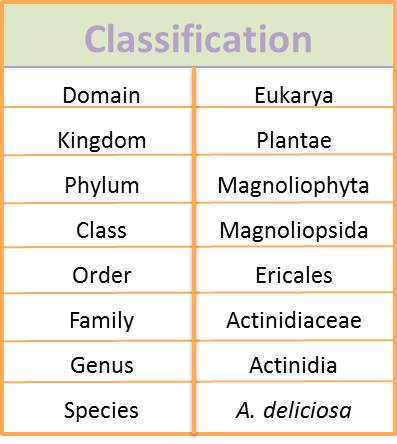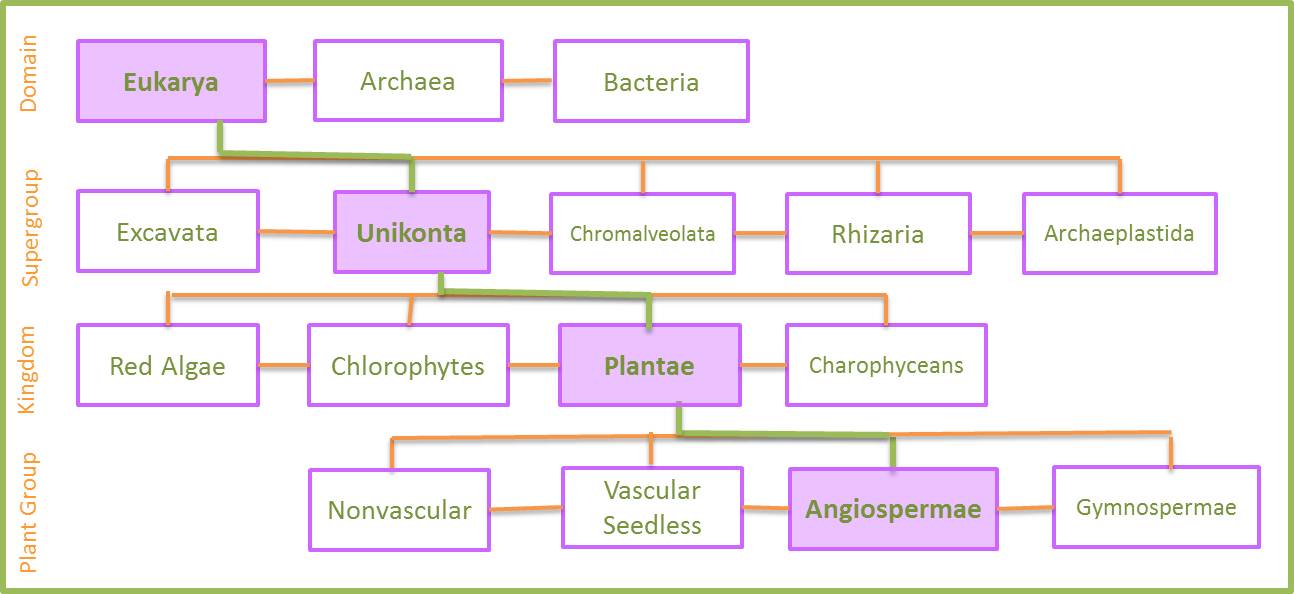Classification
Domain – Eukarya
The domain Eukarya is characterized by each
cell having a nucleus and membrane bound organelles like
mitochondria. These organelles set this group apart from
prokaryotes which do not have a true nucleus. This group
of organisms include protists (like the red algae,
Mastocarpus papillatus), fungi (like
Cordyceps subsessilis), animals (like the
Yeti Crab), and plants (like Actinidia deliciosa).
Kingdom - Plantae
Kiwifruit are categorized in the kingdom Plantae
because they are multicellular and have cell walls made of cellulose. These cell
walls allow for a large amount of structural support and rigidity. Plantae
organisms are also mostly autotrophic and generate their energy via
photosynthesis (which can be explored on the Nutrition
page). Another example of a plant is the Juniper tree,
Juniperus communis L..
Phylum – Magnoliophyta
Actinidia deliciosa is classified in this phylum because like all Magnoliophytas,
it is a true flowering plant that produces a protected seed containing an
endosperm. These types of plants utilize a vascular system for nutrient and
water transport. This phylum is more commonly known as the Angiospermae and another
example of an Angiosperm is the Common Blue Violet,
Viola sororia.
This phylogenetic tree shows the taxonomic breakdown of Actinidia deliciosa from Domain to Plant Group.
Class – Magnoliopsida
The class Magnoliopsida is characterized by being dicots. This means that the plants have
a net-like leaf venation, a flower that parts in 4’s or 5’s, and more
importantly, a seed that contains two cotyledons. Kiwifruit shares this class
with
Carica papaya.
Order – Ericales
The kiwifruit are
classified in this order because of their weakly fused flower petals with radial
symmetry. A thin seed coat, capsule fruit, and common symbiotic relationship
with fungi also allows for A. deliciosa to be grouped in the Ericales.
This phylogenetic tree shows the relationship of Actinidia plants to others that are also classified in the order of Ericales. These findings are molecular based and created by Arne A. Anderberg, Catarina Rydin and Mari Kallersjo in an article of the American Journal of Botany.

Family – Actinidiaceae
Kiwifruit are
categorized in this group because they are a woody vine. Actinidiaceae consists
of woody vines, shrubs, and trees that are native to Asia, Central America and
South America. These plants also have a simple, spiral arrangement of leaves.
Genus – Actinidia
This name is given to
plants that are tough and hardy. The word "actinidia" derives from a Greek word
meaning "difficult" or "hard" and therefore is very suiting for kiwifruit. The vine and skin of the kiwifruit are
extremely tough, resistant, strong and hardy.
Species – A. deliciosa
Kiwifruit's final
classification is given for its fruit. The species name, "deliciosa", derives
from the Greek word meaning "luxury" or "luxurious" and
refers to the luscious taste of the green, fleshy fruit.